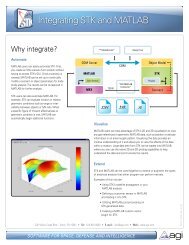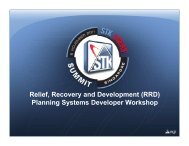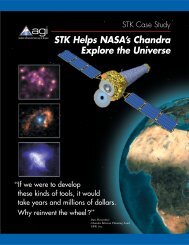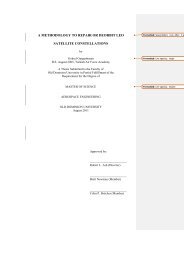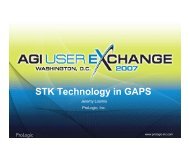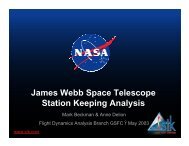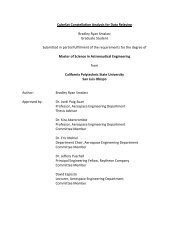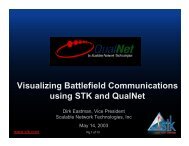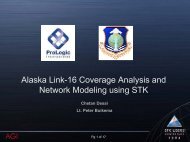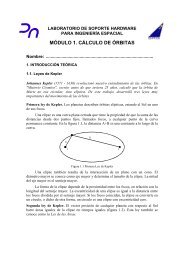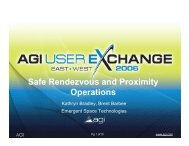Orbit Conjunction Filters Final - AGI
Orbit Conjunction Filters Final - AGI
Orbit Conjunction Filters Final - AGI
Create successful ePaper yourself
Turn your PDF publications into a flip-book with our unique Google optimized e-Paper software.
AAS 09-372A DESCRIPTION OF FILTERS FOR MINIMIZING THE TIMEREQUIRED FOR ORBITAL CONJUNCTION COMPUTATIONSJames Woodburn * , Vincent Coppola † and Frank Stoner ‡INTRODUCTIONClassical filters used in the identification of orbital conjunctions are describedand examined for potential failure cases. Alternative implementations of thefilters are described which maintain the spirit of the original concepts butimprove robustness. The computational advantage provided by each filter whenapplied to the one versus all and the all versus all orbital conjunction problemsare presented. All of the classic filters are shown to be applicable to conjunctiondetection based on tabulated ephemerides in addition to two line element sets.The problem of on-orbit collisions or near collisions is receiving increased attention in light ofthe recent collision between an Iridium satellite and COSMOS 2251. More recently, the crew ofthe International Space Station was evacuated to the Soyuz module until a chunk of debris hadsafely passed. Dealing with the reality of an ever more crowded space environment requires theidentification of potentially dangerous orbital conjunctions followed by the selection of anappropriate course of action. This text serves to describe the process of identifying all potentialorbital conjunctions, or more specifically, the techniques used to allow the computations to beperformed reliably and within a reasonable period of time.The identification of potentially dangerous conjunctions is most commonly done bydetermining periods of time when two objects have an unacceptable risk of collision. For thisanalysis, we will use the distance between the objects as our proxy for risk of collision. We areinterested in when two orbiting objects come closer than a minimum acceptable distance fromeach other. While other measures, such as probability of collision, may be the final desired metricof risk, the distance between two object provides an efficient proxy for identification of events ofinterest. Additional analyses may then be performed on identified events to provide supplementalinformation useful for making decisions regarding potential courses of action.For a problem containing only two objects, the problem of identifying orbital conjunctions issimply solved by computing the distance between the two objects at all points in time during theanalysis period and determining if the distance ever falls below a selected threshold. Applicationof this methodology to the problem of a single object vs the entire space catalog of nearly 20000objects (or worse yet to the problem of all catalog objects vs. all other catalog objects) quicklyillustrates the need for computational acceleration techniques.* Chief <strong>Orbit</strong>al Scientist, Analytical Graphics, Inc., 220 Valley Creek Blvd., Exton, PA, 19341-2380.† Senior Astrodynamics Specialist, Analytical Graphics, Inc., 220 Valley Creek Blvd., Exton, PA, 19341-2380‡ Astrodynamics Engineer, Analytical Graphics, Inc., 220 Valley Creek Blvd., Exton, PA, 19341-2380.1
Hoots et al. 1 designed a series of three filters through which candidate objects have to passbefore a final determination of the close approach distance is made. Two of the filters are purelygeometrical and one uses the known properties of the orbital motion of the two objects. Thesefilters serve to “weed out” the majority of the objects in the catalogue from intense scrutinythereby greatly reducing the number of computations needed. After the application of the filters,the trajectories of the remaining candidate objects are sampled to determine the actual closeapproach periods. The three filters will be referred to as the apogee/perigee filter, the orbit pathfilter and the time filter. These filters have the advantage of being easy to understand, but inpractice they have been shown to be inadequate when implemented as originally described.Additionally, the filters were originally designed for use with a space catalog comprised solely oftwo line element (TLE) sets. Now that a special perturbations version of the space catalog isbeing generated, any dependence on TLE specific information must be eliminated.Healy 2 took a different approach to conjunction detection where filtering is forgone in animplementation designed to take advantage of parallel processing. There is also suggestion in thiswork that special care and additional analysis are required to use the filters described by Hoots etal. which makes their use cumbersome in a parallel processing application. The computations inHealy’s method are based on sampling the relative distance between each pair of orbiting objectsand using a simplified model of the relative motion to efficiently identify potential conjunctionsduring a time step. The candidate conjunctions are then subjected to a more detailed analysisusing the full fidelity orbit model. Rodriguez 3 et al. provide a set of refinements of the methoddescribed by Healy but also incorporate a form of the apogee/perigee filter described by Hoots etal.. The discussion in this reference points out the complexity of the orbit path and time filters andimplies a lack of robustness. While this approach taken in Rodriguez et al. certainly has its merits,we seek to explore the potential of the filters originally described by Hoots et al. to determinewhen and how the concepts behind those filters may be safely applied to improve the speed ofconjunction detection.For each of the filters put forth in Hoots et al., we will examine the premise of the filter,demonstrate failure cases and provide details of an improved implementation. The assumptionsand potential failure cases for the improved implementations will be identified. Requirements forthe use of computational pads will be examined along with the associated impact on computationtime. The computational efficiency provided by reasonable filter combinations will be tabulatedto demonstrate the relative value of each filter. <strong>Final</strong>ly, the reliability of the filtering process willbe evaluated using an “all on all” example where results will be generated with and without theuse of conjunction filters.TRAJECTORY SOURCEThe source of the trajectory information to be used for identifying orbital conjunctions is animportant consideration in the configuration of the conjunction detection process. Historically themain source of ephemeris information used in orbital conjunction analyses has been the catalog oftwo line element (TLE) sets generated by the United States Space Command (USSPACECOM).Ephemeris information is generated from a TLE using the SGP4 General Perturbations (GP)propagation algorithm 4,5 . The SGP4 algorithm allows for the single point computation of satelliteposition and velocity at a time of interest directly from the input TLE. This feature of the analyticpropagation method can be exploited to minimize the number of computations required duringthe conjunction filtering process.In recent times, USSPACECOM has begun generating a second form of the space catalogwhere the trajectory of each satellite is represented by a state vector and force modeling settings2
to be used in conjunction with a specific Special Perturbations (SP) propagator. When using theSP version of the space catalog, it is necessary to numerically integrate the trajectories of eachsatellite either prior to or during the conjunction detection process. The resulting tabulatedephemeris may then be interpolated by standard techniques to compute the satellite position andvelocity at a time of interest. The time required to compute the ephemeris is typically large whencompared to the time required to perform the conjunction detection process. This is even truewhen the “all on all” conjunction problem is addressed 6 . The use of SP ephemeris need notchange the way in which conjunction filters are used, but could result in shorter run timescompared to the use of TLEs if the improved accuracy of the SP generated ephemeris is leveragedto reduce the size of the detection threshold.Another viable source of trajectory information for use in conjunction detection isowner/operator provided data 7 . Tabulated ephemerides provide the most directly usableinformation. Some operators, especially those flying geosynchronous spacecraft, prefer to usesimple analytical models for their trajectories. In this case, the propagation model can beintegrated into the conjunction detection process or can be used external to the process togenerate tabulated ephemerides. Owner/operator provided ephemeris information is typicallymore accurate than USSPACECOM provided information due to the inclusion of cooperativetracking data during the orbit estimation process.It is appropriate to mention at this time there is an important nuance related to the source ofephemeris information that can affect the use of conjunction filters. The apogee/perigee and orbitpath filters are geometric constructs which are based on assumptions of near two-body motion.The conversion between the Cartesian position and velocity of an object and an ellipticalrepresentation of its orbit requires the use of a gravitational parameter for the case of osculatingorbital elements or a gravitational parameter, reference distance and a J2 coefficient of the gravityfield for simple mean orbital elements. Obtaining the correct elliptical representation of the orbitrequires that the appropriate gravity field values be used for all objects. In some cases this willrequire that multiple gravity field values be used in a single analysis. We also note that the meanelements used in this analysis are Kozai-Izsak mean elements 8,9 . Specifically, conversion to theselected mean elements removes the first order short periodic variations due to J2.All results in this paper were generated using the publicly available catalog of TLEs for 11February, 2009. This version of the catalog contained 11970 objects. The analysis runs coveredtime spans between one and five days beginning at 05:00 hours UTC. For cases where timingresults involving the use of ephemeris files is presented, the original TLE information was used toproduce ephemeris files for all objects in the catalog.CONJUNCTION FILTERS<strong>Orbit</strong>al conjunctions are identified through the examination of pairs of trajectories of orbitingobjects. The goal of the process is to find all conjunctions between a set of objects of interest,referred to as primary objects, and the set of all cataloged orbiting objects, referred to assecondary objects. Note that each entry in the set of primary objects is also a member of the set ofsecondary objects and that the set of primary objects can contain all of the secondary objects tocreate the so called “all on all” conjunction problem. <strong>Conjunction</strong> filters provide an efficientmechanism for finding conjunctions by providing quick identification of primary/secondarypairings which cannot come close enough together to yield a conjunction.In general, conjunction filters utilize approximations based on known characteristics of orbitalmotion to maximize the efficiency of the computation. Each filter defines a proxy for the distancebetween two orbiting objects, a candidate conjunction pair, and then either eliminates the pair3
from any further consideration or limits the time periods which require further analysis. We mustbe careful, however, that the accuracy of the results is not compromised by these approximations.One simple method of accounting for approximations is to use distance pads which increase thesize of the conjunction threshold distance during the filtering process to cover the effects of thefilter approximations. The effect of padding is to increase the number of candidate pairing whichpass through each filter as possibly having conjunctions in order to reduce the likelihood that acandidate pair will be improperly eliminated which could lead to a missed conjunction. Thedifficulty associated with using pads lies in selecting pad values that preserve the accuracy of thecomputation while still providing computational benefit. Another technique to minimize theeffects of filter approximations is to perform verification and rectification computations duringthe application of the filters. Such “trust but verify” strategies ensure that the filter processes donot walk away from reality. The length of the analysis interval is an important consideration whenusing filters in the conjunction detection process. Since the filters assume a simplified motionmodel, the errors imparted into the filtering process can increase with the length of the analysisinterval unless mitigating measures are taken. This is of most concern when padding is being usedas the length of analysis interval tends to affect the size of pads required to obtain accurateresults.One additional filter, not described in detail below, is typically applied during the predictionof conjunction events. The out of date filter is used to eliminate secondary objects from considerif their orbital information is not considered to be current enough to support accurate conjunctionidentification.The Apogee/Perigee FilterThe goal of the apogee/perigee filter is to eliminate pairings which cannot produceconjunctions due to a lack of overlap in the range of radius values experienced by the twotrajectories, Figure 1. A simple example of a pairing which would be eliminated by this filter is aGEO satellite vs a LEO satellite.Primary Launch TrajectoryAccepted CandidateFiltered CandidateFigure 1. Apogee/Perigee Filter GeometryThe original description of the apogee/perigee filter given by Hoots et al. recommendscomputing the apogee and perigee radii for the primary and secondary objects at the start of theanalysis interval. The reasoning was that the perigee radius would remain constant and the apogee4
adius would decrease over the interval. The method for determining the apogee and perigeevalues at the start time was based on determining orbital elements at the midpoint of the analysisinterval and using approximate rates of those elements to project values at the start time. Theapproximate rates of the mean motion and eccentricity were computed using the time derivativeof the mean motion, which is part of a TLE but is not readily available for other forms of orbitdata. This makes an exact implementation of the filter as previously described difficult for thecase of varying ephemeris sources. While not explicitly stated, we believe that apogee andperigee radii were computed based on mean orbital elements.There is one extremely important feature of the apogee/perigee filter that is critical tounderstanding its potential benefit: the computations associated with the apogee/perigee filterneed only be performed once for each object, not once for each pair of objects. The application ofthe computed apogee and perigee values to pairs of objects only requires simple comparisons.This is not important for the case of one primary, but is a huge distinction for the case of “all onall” conjunction analysis since the computational load increases by order N instead of N 2 as is thecase with the other filters.For the purpose of this study we computed the apogee and perigee values at the start timebased on osculating and mean orbital elements. Testing the radial distance overlap conditionbased on information at a single epoch within the analysis span can be shown to lead to theerroneous elimination of candidate pairs. The approximation breaks down due to periodicvariations in the elliptical representation of the orbits due to J2 and luni-solar perturbations. Table1 contains an example test case which yields a conjunction based on a 5 Km detection thresholdwhich is missed when applying the apogee/perigee filter based on the osculating orbit elements atthe start time of the analysis period. In this case, the candidate pair was rejected by theapogee/perigee filter even though the actual minimum and maximum radius values for theprimary object were used during the filtering process leaving the only source of error to be thecomputed apogee and perigee values for the secondary object.Table 1. Apogee/Perigee Filter Failure CaseObjectPrimarySecondaryTwo Line Element Set1 17191U 86097A 09042.77558376 .00000463 00000-0 33698-4 0 42412 17191 82.5015 115.7853 0012022 11.7757 348.3745 15.014501872050771 26281U 99057FT 09042.35988229 .00004627 00000-0 30570-3 0 98962 26281 98.3425 293.5702 0025414 292.4435 67.4052 15.07724983479847Figure 2 shows comparisons of computed apogee and perigee radius values for the Low Earth<strong>Orbit</strong>ing (LEO) satellite, SSC #26281. The reason for the failure of the apogee perigee filterbased on a single sample of the osculating orbit elements at the start time of the analysis isevident. The sampled value for the apogee at the start time of 6913 km is in error byapproximately 20 km from the actual value of the apogee and causes the filter to determine thatthere is no overlap with the SSC #17191 which had a perigee value of 6929 km. For the case ofSSC #26281, it appears that the apogee and perigee radius values as computed from mean orbitalelements are better suited for conjunction filtering than those computed from osculating values.5
694569356925Radial Distance (km)691569056895<strong>Orbit</strong> radiusOsculating perigeeOsculating apogeeMean perigeeMean apogee68850 3600 7200 10800 14400 18000 21600Time (secs)Figure 2. Comparison Of Computed Values Of Apogee And Perigee (LEO, SSC 26281)The behavior of Highly Eccentric <strong>Orbit</strong>s (HEO) is seen to be significantly different than thatof the nearly circular LEO orbit. The HEO orbit used for this analysis is actually a GeostationaryTransfer <strong>Orbit</strong> (GTO) with perigee in LEO and apogee near the geostationary belt. In this case,the computed osculating and mean apogee and perigee radius values both provide poorrepresentations of the actual apogee and perigee values unless they are sampled near the time ofthe extremum, Figure 3. The difficulty in this case is caused by the effects of third bodyperturbations which are not removed in the selected mean element theory. The HEO result alsodemonstrates that the assumption of a constant perigee radius does not apply for this type of orbit.6
68986897689668956920Radial D istance (km)689468936892689168906889Distance (km)6900688871340 72060 72780 73500 74220 74940Time (secs)Osculating perigeeMean perigeePerigee68800 72000 144000 216000 288000 360000 432000Time (secs)429004285042800Distance (km)42750428804270042875428704286542650Osculating apogeeMean apogeeApogee42860428554285083940 86940 89940 92940 95940 98940 101940426000 72000 144000 216000 288000 360000 432000Time (sec)Figure 3. Comparison Of Computed Values Of Apogee And Perigee (HEO, SSC 23687)Two methods for improving the apogee/perigee filter were investigated. The first methodinvolves adding a pad to the detection threshold and sampling each trajectory at the beginningand end of the analysis interval to determine the range of radial distance for each object. Thereason for sampling at both ends of the analysis interval is to capture the effects of trends in the7
apogee or perigee values as was observed in the case of the HEO. The use of multiple samplesshould also reduce the chance of using a particularly unfortunate sample such as at the bottom ofa trough in Figure 3. The application of pads during the filtering process provides a simple meansof accounting for periodic effects on the orbit trajectories. The goal in the selection of the padvalue should be to select the minimum value that sufficiently covers the periodic effects. Theminimum value is desirable to minimize the number of candidate pairing which will pass throughthe filter and thus reduce the required processing time. The selection of a minimum sufficient padvalue is difficult, however, especially when Highly Eccentric <strong>Orbit</strong>s (HEO) are involved. As aresult, the pad needs to be set large enough to cover all test cases.To provide an estimate of the required pad sizes, a simple analysis was performed on the set ofcatalog objects to determine the maximum error between the actual largest and smallest radiivalues for each object and what would be predicted by computing the osculating or mean orbitelements at the start and end times of the analysis interval. Based on the resulting graphs, shownin Figures 4 and 5, it appears that using a pad of approximately 30 Km per satellite would besufficient to capture all cases successfully. We note that if a small number of primaries are beingconsidered, then sampling of the primary trajectories can be done to determine their actual radialextents thus reducing the padding requirement to that of a single satellite. While this result isstrictly valid only for the test case used, we have found it effective in practice. As shown inFigure 3, however, it is still possible for the apogee/perigee filter to fail under these conditions.50403020Perigee Error (km)1001 1001 2001 3001 4001 5001 6001 7001 8001 9001 10001 11001-10-20-30-40ObjectOsculatingMeanFigure 4. Perigee Approximation Errors8
3020Apogee Error (km)1001 1001 2001 3001 4001 5001 6001 7001 8001 9001 10001 11001-10OsculatingMean-20ObjectFigure 5. Apogee Approximation ErrorsA more reliable method for improving the robustness of the apogee/perigee filter is tosparingly sample all trajectories to determine the minimum and maximum radial distance for eachone. This method requires significantly more computation than the first method where the objectpositions and velocities were only required at the start and end of the analysis interval, but theresulting values may be used with much smaller pads, 1 km is sufficient, thus increasing thenumber of candidate pairs which are filtered. This trade off will become important as the numberof primary objects is increased. The computational cost of this method is also highly dependenton the source of ephemeris information. It is much more costly when used with orbit informationspecified by TLEs than when tabulated ephemeris is used. Another advantage of the samplingmethod is that one need not make any assumptions about the type of motion which occurs overthe analysis interval. This allows for the application of the filter to cases where the trajectoriesunder consideration contain maneuvers. The efficiency of the technique by which we sample anddetect the min/max radii will have a significant impact on the performance of the filter whenusing this method.The <strong>Orbit</strong> Path FilterThe goal of the orbit path filter, called the geometric pre-filter in Hoots et al., is to eliminatepairings which cannot produce conjunctions because the distance between their orbits remainsabove the conjunction threshold, irrespective of the actual locations of the objects along the paths.For the case of two circular orbits, the solution of the minimum distance between the paths issimple and is computed at the relative line of nodes, Figure 6. This solution was used by Hoots etal, as the starting point for a Newton iteration scheme to solve the more general problem wherethe orbit paths are elliptical. For cases where either orbit has moderate eccentricity, however, theNewton method usually requires an initial guess which is closer to the final solution than thepoints along the relative node in order to converge. Woodburn and Dichmann 10 presented an9
}improved algorithm for computing the distance between the elliptical paths. The orbit path filteras described may not be applied to objects in coplanar orbits as the algorithm for finding theclosest point between the paths becomes ill defined. For coplanar cases, the candidate pair ispassed through for additional consideration.Secondary ellipsePrimary ellipsea}Relative node lineFigure 6. <strong>Orbit</strong> Path Filter GeometrySuccess of the orbit path filter depends upon the time at which the filtering metric iscomputed. Hoots et al. recommend sampling once at the midpoint of the analysis interval andcomputing the rate of change of the path to path distance based on the secular rates of the orbitelements due to effects of oblateness. The rate at the midpoint is then projected to the start andend times of the interval. If the minimum resulting path to path distance based on the sampledvalue and the two projected values is less than the detection threshold then the candidate pair ispassed through the filter. While not explicitly stated, it is assumed that path to path distances werecomputed based on mean orbital elements.As was the case with the apogee/perigee filter, the computation of the rates of the orbitalelements requires information which is not generally available. As an alternative to using therates, we have chosen to compute sample the path to path distances at the start, middle and end ofthe analysis span. The pair of TLEs contained in Table 2 provide a test case for which the orbitpath filter fails under this sampling strategy. In this case, all three samples are well above thedetection threshold of 5 km, yet a conjunction occurs.Table 2. <strong>Orbit</strong> Path Filter Failure CaseObjectPrimarySecondaryTwo Line Element Set1 00130U 61015Q 09042.53163123 -.00000058 00000-0 13804-4 0 18912 00130 66.7709 101.1030 0080133 49.8006 311.0048 13.980861604261451 10730U 75027E 09041.68856875 -.00000310 00000-0 -10589-3 0 60112 10730 114.9454 275.4040 0122342 287.9987 70.7850 13.9273761972161910
Similar to our first approach with the apogee/perigee filter, we can apply a pad to the detectionthreshold to avoid missing conjunctions due to the simplifying assumptions of the path filter. Togain insight into the size of pad that may be required, a time history of the distance between thepaths for the objects in Table 2 was generated. Figure 7 shows a comparison of the path to pathdistance computation for this case where the distance is computed using both mean andosculating orbital elements. The graph clearly demonstrates two things: the computation usingosculating elements contains far too much frequency content to be useful under a condition ofminimal sampling and the computation using mean elements can differ significantly from theactual instantaneous value of the metric.It is clear based on Figure 7 that simply applying a pad, while it may account for thedifferences between the mean and osculating orbit representations, will not solve the problem ofimproper elimination of candidate pairs in the orbit path filter. A better sampling strategy is alsorequired and needs to be combined with technique to find the minimum of the path to pathdistance over the analysis interval. We note that had we used the metric as proposed by Hoots etal., the filter would not have failed in this case, but it can clearly be seen that there are large areasof the curve where the filter would have failed had the sample been taken there.1009080Mid sample timeDistance Between <strong>Orbit</strong>s (km)70605040302010ThresholdOsculatingMean00 12000 24000 36000 48000 60000 72000 84000Time (secs)Figure 7. Computed Distance Between <strong>Orbit</strong>s Using Osculating And Mean ElementsThe orbit path filter requires a fairly complex computation, the path to path distance betweentwo orbits, the result of which has been shown to have non-trivial behavior. This observedbehavior of the path to path distance metric needs to be wrapped in additional event detectionlogic to identify cases of possible conjunction as shown in Figure 7. The event detection logicneeds to include a sampling strategy which allows for the detection of the important trends in thesampled metric. While these additional refinements to the algorithm described here are possible,the coding complexity and computational load of the filter may out weigh its benefit. It should11
also be noted that use of the orbit path filter is restricted to cases where neither object ismaneuvering.The Time FilterThe goal of the time filter is to identify time intervals when each object in a pairing is closeenough to the elliptical representation of the other objects trajectory to have a conjunction. Theactual metric computed is the distance of primary object from the orbit plane of the secondaryobject, Figure 8. Since this distance is always guaranteed to be less than the actual distancebetween objects, the metric is a conservative proxy for the separation distance. Pairings areeliminated from further consideration when there is no overlap between the intervals associatedwith the primary object and those associated with the secondary object. If a pairing does passthrough this filter, the amount of time over which more detailed event detection must be istypically limited to a fairly small number of relatively short intervals. This filter works on thepremise that both objects have to be in the right place at the right time for a conjunction to occur.Intervals are generated for each object independently and are anchored to the relative nodebetween the two orbits. The condition for a possible conjunction is that an interval around theascending node for the primary object overlaps with an interval around the descending node forthe secondary object or visa versa, Figure 9. Like the orbit path filter, the time filter is limited tocases where the trajectories are not coplanar and neither object is maneuvering.Plane of primary ellipsedEdge viewof secondaryellipsedRelative nodeFigure 8. Distance From Primary To <strong>Orbit</strong> Plane Of Secondary12
Secondary descendingPrimary ascendingSecondary ascendingPrimary descendingFigure 9. Relative Node CrossingsThe original concept for generation of time intervals as presented by Hoots et al. involvesgenerating a series of intervals for each object when the metric satisfies the threshold conditionstarting with an interval near the mid point of the analysis period. The relative nodal period,corrected for the effects of drag and oblateness, is then used to generate a series of intervalscovering the analysis time period. The corrections for drag are computed in terms of the rate ofthe change of the mean mean motion, which is provided as part of a TLE. The idea of starting atthe midpoint of the analysis interval is to reduce the effect of perturbations which are notaccounted for in the formulation of the filter. While this methodology is very efficient atgenerating intervals, experience has shown that generated intervals do not necessarily representthe actual times near the relative node. We do not show a specific failure case for this filter sinceall failures are simply related to an inability to compute a relative nodal period which is validover the entire analysis interval.The robustness of the time filter can be improved significantly by modifying algorithm to usea “trust but verify” approach to the generation of node crossing intervals. The modification to theinterval generation involves finding the precise period between the first two ascending relativenode intervals and the first two descending relative node intervals for each satellite. The relativenode times are computed using osculating elements since we are now interested in specific nodalcrossing times. The next interval of each type (ascending or descending) is then generated byadding the previous period. The new relative node intervals are then tested and corrected whichyields new estimates of the ascending and descending relative nodal periods. The testing of therelative node crossing times requires more computation time than the original method, but allowsthe time filter to be applied in a safe manner. One way to reduce the amount of time required bythe new methodology is to relax the requirement of correcting every nodal crossing to one ofcorrecting every Mth nodal crossing. The correction at the Mth nodal crossing can then bemonitored and the algorithm can reduce the initial value of M if the error in the predicted nodalperiod is too large. A simple way to maintain the integrity of the interval solutions in this case isto lengthen both ends of the computed intervals by a time pad and then verify that the correctionin the node time at the Mth nodal crossing is less than the time pad. The general algorithm forgenerating the intervals which bound the crossings of the relative nodes is depicted in Figure 10.13
Rectify = trueCounter= 0Estimate Nodal Periodτ NLocate First Nodeτ NEstimate Next NodeRemove Suspect IntervalsNoRectify?Yes− −MaxNo Rectify+ +Counter = MaxNoRe ctify??Rectify Node EstimateRe ctify = trueCounter= 0Estimate Nodal Periodτ NCorrection to large?YesCompute Nodal IntervalNoNoDone?YesReturnFigure 10. Relative Node Interval GenerationRange Threshold DetectionFor the case where a minimum range threshold is being used as the measure of conjunctionrisk, it is ultimately necessary to determine the actual periods where the range is less than theoperator specified value. In reality, these periods, or at least the time of closest approach,generally need to be identified regardless of the risk metric. It is therefore necessary to employ anevent detection scheme to identify precise conjunction events. The event detection needs tooperate over the intervals of time which cannot be eliminated by the filters. The efficiency of theof the event detection algorithm has a large impact on the overall performance of the conjunctionidentification process when the time filter is not used. When the time filter is used, however, theamount of time spent in event detection is reduced to a level where the efficiency of the eventdetection is much less important.RESULTSThe series of filters described above were applied to the problems of conjunction detection foreach of the following problems: one LEO primary, one GEO primary, one GTO primary, 10 LEOprimaries, 10 GEO primaries and “all on all”. The object ids used as primaries for each problemare listed in Table 3. A variety of filter configurations were tried for each problem. Thecombination of a problem and a filter configuration will be referred to as a test case. Descriptionsof the filter configuration are given in Table 4. The filters were applied in the order listed in Table5. Each test case was run with two ephemeris sources: TLEs and tabulated ephemeris. For eachrun, the computation times are normalized by the time required to perform the conjunctionanalysis without filters and are reported as speed up factors. A reported value of 2, for example,indicates that the computation required half the time required for the no filter case. The results are14
given in Table 5 with values listed inside parentheses indicating speed up factors when tabulatedephemeris was used. It is important to note that for cases where tabulated ephemeris was used, thespeed up factors were computed after the common time to load the ephemeris into memory wassubtracted from the overall process time. In these cases, the time required to load the ephemerisaccounted for the vast majority of the overall process time so the practical effect of the filters isnot nearly as great as indicated by the values in Table 5. The numbers in Table 5 should bethought of as being representative of the effectiveness of the various filter combinations, but willvary with specific primary selections and filter implementations. Due to the problems notedabove, 4 out of 5338 total conjunctions were missed in the all on all test case when the orbit pathfilter was used. Associated timing results are shown in yellow in Table 5. The decision to includethe results was to show the potential benefit of the orbit path filter if further improvements to itsimplementation were made.Primaries1 LEO SSC#107301 GEO SSC#263521 GTO SSC#23687Table 3. Descriptions Of Primary Object Sets Used In Timing TestsDescription10 LEO 10 IRIDIUM satellites SSC# 24837, 24839, 24840, 24869, 24872, 24965, 25577,25578, 25777, 25778.10 GEO 10 INTELSAT satellites SSC# 20315, 20523, 22871, 23175, 24916, 25473, 26590,26766, 28358, 32253.All on AllFull catalog of 11970 objectsTable 4. Descriptions Of <strong>Filters</strong> Used In Timing TestsFilterAPPAPSOPTDescriptionApogee/perigee filter using precise apogee/perigee computation for primary objectsand sampling at the beginning and end times of the analysis interval for secondaryobjects. Pad of 30 km.Apogee/perigee filter using precise apogee/perigee computation for primary andsecondary objects. <strong>Orbit</strong>s sampled every 20 degrees of true anomaly. Pad of 1 km.<strong>Orbit</strong> path filter using samples at the beginning, middle and end of the analysisinterval based on mean orbit elements. Pad of 30 km.Time filter using a maximum number of 5 consecutive nodes without rectification.Pad of 30 km plus 10 seconds on each side of the computed interval.15
Table 5. <strong>Conjunction</strong> Timing Results<strong>Filters</strong> 1 LEO 1 GEO 1 GTO 10 LEO 10 GEO All on AllAPP 1.7 (2.2) 9.6 (11) 1 (1) 3 (2.6) 13 (12) 2.3 (2.5)APP/T 12 (5.9) 26 (17) 9.3 (2.5) 40 (7.3) 57 (20) 17 (15)APP/OP/T 16 (7.3) 31 (20) 34 (5) 54 (8.5) 57 (19) 40 (32)APS 0.79 (0.98) 0.95 (0.74) 0.53 (0.57) 4.3 (2.8) 9.1 (5.6) 2.5 (2.5)APS/T 1.2 (1.1) 1 (0.75) 0.96 (0.9) 15 (6.2) 13 (6.4) 18 (18)APS/OP/T 1.2 (1.2) 1 (0.76) 1.1 (1.1) 16 (10) 14 (6.4) 42 (34)When comparing the numerical results in Table 5, it is important to remember that thenumbers represent computational acceleration factors. In this sense, a value of 15 is not five timesbetter than a value of 10, it is 50% better. It should also be noted that there is significantuncertainty, probably on the order of 25%, in the reported values and that the specifics of aparticular implementation will have a strong influence on the results as well.Several things jump out immediately from the tabulated timing results. First, locating theprecise apogee and perigee values for the secondaries (APS) in the apogee/perigee filter can resultin longer run times than when no filters are used for cases where only a single primary satellite isconsidered. When larger numbers of primaries are considered, however, the up frontcomputational hit of the APS filter is compensated for by the improved efficiency of the filter interms of eliminated candidates. In the case of all on all conjunction processing, the APS filterprovides the same performance as the less robust APP version. Second, the time filter is seen toprovide the largest jumps in computational efficiency of all of the filters. This is due to the factthat the time filter not only eliminates candidate objects, it also greatly reduces the amount oftime required for detailed analysis on the remaining conjunction candidates. <strong>Final</strong>ly, the orbitpath filter is seen to be most effective in reducing the computational time for highly eccentricorbits. This is mainly due to the fact that the apogee/perigee filter is not effective in reducing thecandidate population for these types of orbits. In the case of near circular LEO and GEO primaryobjects, the orbit path filter is least effective of all of all of the filters but it does reduce the timerequired for all on all conjunction detection by a factor of two.CONCLUSIONThe use of a series of filters has been shown to be an effective means for reducing thecomputation time required for conjunction analyses. Two of the three classic filters, theapogee/perigee filter and the time filter, have been shown to be robust based on modifications tothe implementation strategies. The orbit path filter is seen to be the most troublesome of theclassic filters. Except for the case where the primary objects are in HEO or the all on all case, theassociated computational benefit does not justify the additional effort required to improve therobustness of the filter. The recommendation of this paper is, therefore, to not use the orbit pathfilter. The time filter is seen to provide the greatest reduction in required computation timedespite the more complicated logic involved in the modified implementation.16
The filters as described here are equally applicable to conjunction analyses based on two lineelement sets or tabulated ephemerides. The efficiency gains differ depending on the ephemerissource due to the much higher cost of computing the position of an object using SGP4 comparedto interpolating a provided ephemeris. The use of tabulated ephemerides results in an up frontcost due to the time required to load the ephemerides into memory, which scales linearly with thenumber of secondary objects, N. The up front cost is quickly overcome as the number ofprimaries, M, is increased due to the improved efficiency of filter operations whose cost isproportional to N*M.REFERENCES1 Hoots, F.R., Crawford, L.L. and Roehrich, R.L. “An Analytic Method to Determine Future Close ApproachesBetween Satellites”, Celestial Mechanics, Vol. 33, 1984, pp. 143-158.2 Healy, L.M., “Close <strong>Conjunction</strong> Detection on Parallel Computer”, Journal of Guidance, Control and Dynamics, Vol18, No. 4, July-August 1995.3 Rodriguez, J.R.A., Fadrique, F.M.M, Klinkrad, H., “Collision Risk Assessment with a Smart Sieve Method”,Proceedings of the Joint ESA-NASA Space-Flight Safety Conference, ESTEC, Noordwijk, Netherlands, June 2002.4 Hoots, F.R., and Roehrich, R.L., “Spacetrack Report #3: Models and Propagation of the NORAD Element Sets”, U.S.Air Force Aerospace Defense Command, Colorado Springs, CO, 1980.5 Vallado, D.A., Crawford, P., Hujsak, R., Kelso, T.S., “Revisiting Spacetrack Report #3”, AIAA 2006-6753, 2006AIAA/AAS Astrodynamics Specialists Conference, Keystone, CO, August 2006.6 Coppola, V., Dupont, S., Ring, K., Stoner, F., “Assessing Satellite <strong>Conjunction</strong>s for the Entire Space Catalog usingCOTS Multi-core Processer Hardware”, AAS 09-374, 2009 AAS/AIAA Astrodynamics Specialists Conference,Pittsburgh, PA, August 2009.7 Kelso, T.S., Vallado, D.A., Chan, J. Buckwalter, B., “Improved <strong>Conjunction</strong> Analysis via Collaborative SpaceSituational Awareness”, 2008 AMOS Conference, Maui, Hawaii, September 2008.8 Kozai, Y., “The Motion of a Close Earth Satellite”, The Astronomical Journal, No. 64, pgs 367-377, November 1959.9 Izsak, I.S., “A Note on Perturbation Theory” The Astronomical Journal, No. 68, pgs 559-561, October 1963.10 Woodburn, J. and Dichmann D., “Determination of Close Approaches for Constellations of Satellites”, Paper No. C-5, IAF International Workshop on Mission Design and Implementation of Satellite Constellations, Toulouse, France,November 1997.17



